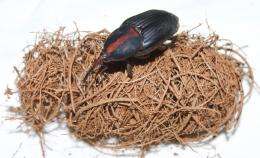The red palm weevil.
Scientists and growers met on campus Friday, Oct. 22, to address a potentially devastating new threat to California?s iconic palm trees: the red palm weevil.
Confirmation was received this week that the red palm weevil, considered the world’s most damaging insect pest of palm trees, has been found in Laguna Beach, Orange County, Calif.
The weevil was discovered infesting a Canary Islands palm in a residential area by a landscape specialist in September 2010. The insect was subsequently positively identified as Rhynchophorus ferrugineus, the red palm weevil, by experts at the USDA-ARS Systematic Entomology Laboratory, Md. Weevil larvae bore tunnels through palm trunks as they feed, eventually killing the trees.
Thomas O. Baldwin, dean of UC Riverside’s College of Natural and Agricultural Sciences, and Albert Keck, chairman of the California Date Commission and a major palm grower in the Coachella Valley, convened the meeting to plan on strategies for containing and eradicating the weevil, which has caused enormous damage elsewhere in the world. The Orange County sighting is the first appearance of the weevil in the United States.
Keck, president of Hadley, Inc., which supplies dates to the food industry and palm trees to the landscape industry, said, “This problem is central to our livelihood.” Noting that palm trees are an integral part of the Southern California landscape, he said that the potential impact of the weevil on the state and beyond would be catastrophic on both economic and emotional fronts.
The university is preparing a proposal to collaborate with the California Department of Food and Agriculture to manage the weevil and the threat it poses to the public and industry. They also plan an informational campaign to alert and educate homeowners. A follow-up meeting is planned for 2 p.m., Friday, Oct. 29 at UCR.
Entomologist Mark Hoddle, the director of the Center for Invasive Species Research at UCR, noted, “The international trade in live palms is the most likely source for this pest. It was probably moved as eggs, larvae, or pupae hidden inside palms. These can travel great distances because they live with their food supply.” Once larvae emerge as new adults, they abandon their original host plant and fly to new palms, traveling as many as 7 km (~4.3 miles) in 3-5 days.
Adult red palm weevils are large beetles with body lengths of 35 to 40 mm (1.4-1.6 inches). The weevils have a long, slender “snout” which the female uses to penetrate palm tissue and create access wounds in which eggs are deposited. Adult weevils are predominately reddish-brown in the most typical form. The weevil collected in Laguna Beach has a single, contrasting red stripe running the length of the snout. The larvae are legless grubs, pale yellow with a brown head, some larger than 50 mm (2 inches).
“A strong message needs to go out as soon as possible to arborists and others in industry to keep an eye out for this deadly pest,” Baldwin said. “Unlike many previous agricultural pests, the red palm weevil is also an urban problem. We at the university have two ways to proceed: we assume the pest has already spread or we wait to see signs of it having spread. We are not willing to wait.”
More information: Homeowners and others who are concerned about their palms should visit the Center for Invasive Species Research website for more information: cisr.ucr.edu/red_palm_weevil.html .
Provided by University of California, Riverside





















